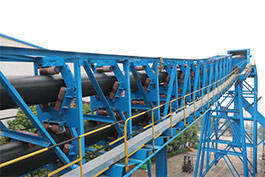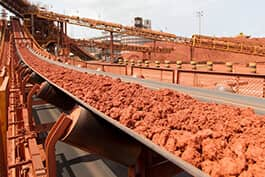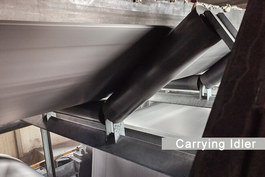A reversing shuttle conveyor is, in short, a belt conveyor that is mounted on to a rail system. The conveyor has the ability to move along the rails in either direction and the belt can be switched for either direction, making this style conveyor great for evenly filling multiple hoppers or storage bins. The conveyor is typically half the length of the rails, giving it plenty of room for several discharge locations. Both functions, belt direction and shuttle movement, can be automated or controlled by an operator.
Shuttle conveyors are trough belt conveyors mounted on trolleys with wheels which travel on rails. They receive feed from feed hoppers located above them and in turn feed bunkers placed below them and spaced at desired distances.
- The structural of steel frame is well welded to be strong and stable.
- Controlled by local operation or by remote control station
- EXCT provide safety and limit switches to raise the safety standard.
- Reversible Belt Direction: The reversing terminology refers to added control of the belt’s conveying direction. The ability to control this means that the reversing shuttle conveyor is not restricted to which end of the conveyor material can discharge from.
- Controlled by Remote control station/Automation operation: Reversing shuttle conveyors can either be controlled from a remote location, such as a control room, by trained personnel, or automatically, through an automated program. This greatly reduces the labor cost of sorting and storing materials.
- The conveyor has the ability to move along the rails in either direction and the belt can be switched for either direction, making this style conveyor great for evenly filling multiple hoppers or storage bins. The conveyor is typically half the length of the rails, giving it plenty of room for several discharge locations.
| Shuttle Conveyor Technical Specifications |
| Belt speed (m/s) |
Belt width(mm) |
| 500 |
650 |
800 |
1000 |
1200 |
1400 |
| capacity ((m³/h) |
| 1 |
104 |
191 |
298 |
486 |
712 |
990 |
| 1.25 |
124 |
227 |
354 |
577 |
846 |
1177 |
| 1.6 |
150 |
275 |
429 |
700 |
1025 |
1426 |
| 2 |
177 |
325 |
507 |
826 |
1210 |
1683 |
1. Material to be processed:__________;
2. Bulk density:_______(t/m³);
3. Handling capacity: __________(t/h);
4.Max. granule size of the feeding material: ______mm;
5. Center distance between the head and tail pulley:__________(m);
6. How many meters does shuttle conveyor travel :_____(m);
7.What equipment is used to feed the material into the shuttle conveyor:______
8.Working power supply: _____V ______ HZ
9. As we know, the shuttle conveyor work with other equipment to form a system, therefore, we will appreciate if you can provide us the preliminary design or hand-drawn sketch for our engineers reference.










